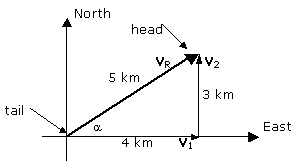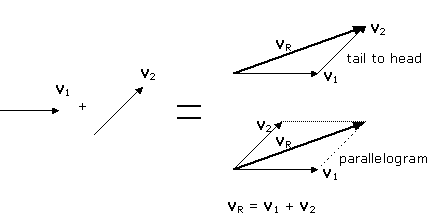VECTORS AND SCALARS
In physics we must distinguish between vector quantities and scalar quantities.
A vector is an oriented quantity, it has magnitude and direction like velocity, force and displacement.
Scalars have no direction associated to them, only magnitude, like time, temperature, mass and energy.
Vectors are represented by arrows where the length of the arrow is drawn proportionally to the magnitude of the vector.
The letters denoting vectors are written in boldface.
1.- VECTORS ADDITION. GRAPHIC METHOD.
To add scalars like mass or time, ordinary arithmetic is used.
If two vectors are in the same line
we can also use arithmetic, but not if they are not in the same line.
Assume for example you walk 4 km to the East and then 3 km to the North, the
resultant or net displacement respect to the start point will have a magnitude
of 5 km and an angle ![]() = 36.87º with the positive x direction. See figure.
= 36.87º with the positive x direction. See figure.

The resultant displacement VR , is the sum of vectors V1 and V2, that is we write
VR = V1 + V2 This is a vector equation.
The general rule to sum vectors in a graphic way (geometrically) which is in fact the definition how vectors are added, is the following:
(1) Use a same scale for the magnitudes.
(2) Draw one of the vectors, say V1.
(3) Draw the other vector V2, placing its tail on the head
of the first one, making sure to keep its direction.
(4) The sum or resultant of the vectors is the arrow drawn from the tail of
the first vector to the head of the second vector.
This method is called vector addition from tail to head.
Notice that V1 + V2 = V2 + V1, that is, the order does not matter.
This tail to head method can be extended to three or more vectors. Suppose we want to add the vectors V1, V2 and V3 shown below:

VR = V1 + V3 +V3 is the resultant vector outlined with a heavy line.
A second method to add two vectors is the parallelogram rule equivalent to the tail to head method. In using this parallelogram rule the two vectors are drawn from a common origin and a parallelogram is formed using the two vectors as adjacent sides. The resultant is the diagonal drawn from the common origin.

2.- SUBTRACTION OF VECTORS
Given a vector V it is defined the negative of this vector (-V) as a vector with the same magnitude as V but opposite direction:

The difference of two vectors A and B is defined as per this equation:
A - B = A + (-B)
So we can use the addition rules to subtract vectors.
3.- MULTIPLICATION OF A VECTOR BY A
![]() REAL
NUMBER.
REAL
NUMBER.
A vector V can be multiplied by a real number c. This product is defined in such a way that cV has the same direction as V and magnitude cV. If c is positive, the sense is not altered. If c is negative, the sense is exactly opposite to V.
More on This Theme:
· Vectors, Scalars - Sum: Analytic Method
· Vectors, Addition Tools, Problems
Other Related Sites:
· Physics, Main Page
· Physics, Mathematics
· Physics, Detailed Homework Scope Help
· Energy, Work and Power: Concepts
· Kinetic Energy
· Potential Energy
· Power
· Physics Problems, Example
· Physics Homework - Mechanical Energy Conservation Problems
· Physics Homework - Mechanical Power Problems
· Coulomb's Law
· Exercises Using Coulomb's Law
· Electric Field Charges
· Electric Field Exercises
· Electric Potential Energy
· Exercises, Electric Potential Energy
· Ohm's Law, Principle
· Ohm's Law Exercises
· Gauss' Law
· Gauss' Law Exercises
· Second Newton's Law
· Second Newton's Law Examples, Part One
· Second Newton's Law Examples, Part Two
· Sound Waves
· Sound Waves: Standing, Interference, Doppler Effect - Examples
· Sound Waves, Doppler Effect - Examples
· Free Fall Theory
· Free Fall Exercises, Part One
· Free Fall Exercises, Part Two
· Free Fall Exercises, Part Three